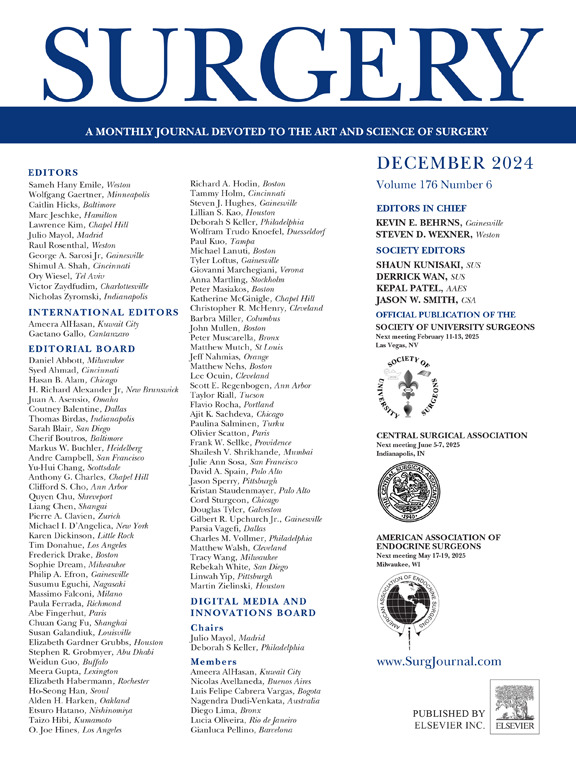Periarterial divestment for borderline and locally advanced pancreatic cancer: An analysis of 125 cases in a single center
IF 3.2
2区 医学
Q1 SURGERY
引用次数: 0
Abstract
Background
Literature on factors influencing prognosis after periarterial divestment for borderline resectable or locally advanced pancreatic ductal adenocarcinoma and preventative measures for postpancreatectomy hemorrhage is scarce. This study aimed to evaluate the efficacy of Neuro-Patch for arterial reinforcement in preventing postpancreatectomy hemorrhage and explore the oncologic outcomes of patients with borderline resectable or locally advanced pancreatic ductal adenocarcinoma following periarterial divestment.
Methods
We conducted a retrospective analysis of 125 patients with borderline resectable or locally advanced pancreatic ductal adenocarcinoma involving arteries who underwent periarterial divestment between January 2018 and May 2022.
Results
Among the study cohort, 54 patients underwent pancreaticoduodenectomy, 43 had distal pancreatectomy, and 28 received total pancreatectomy, with 74 patients also undergoing combined venous resection. Periarterial divestment was performed on the hepatic artery in 47 patients, the celiac artery in 3, the superior mesenteric artery in 22, and multiple arteries in 53. Neoadjuvant chemotherapy was administered to 24% of patients, with an R0 resection rate of 33.6%. The median postoperative hospital stay was 10 days, with a 90-day mortality rate of 3.2%. Neuro-Patch was used in 51 patients, leading to a significant reduction in postpancreatectomy hemorrhage (odds ratio 0.073, 95% confidence interval 0.007–0.783, P = .031). The median overall survival was 20.6 months, with 1- and 3-year survival rates estimated at 73.2% and 22.9%, respectively. Neoadjuvant chemotherapy (hazard ratio 0.494, 95% confidence interval 0.291–0.839, P = .009) and venous invasion (hazard ratio 2.041, 95% confidence interval 1.308–3.186, P = .002) emerged as independent predictors of overall survival.
Conclusion
Neoadjuvant chemotherapy significantly enhances survival outcomes of patients with borderline resectable or locally advanced pancreatic ductal adenocarcinoma undergoing periarterial divestment, and it should be regarded as a standard preoperative approach. The Neuro-Patch provides structural reinforcement to the arterial wall, potentially reducing the risk of postpancreatectomy hemorrhage. However, randomized controlled trials are necessary to substantiate its efficacy and safety.
动脉外剥离术治疗边缘性和局部晚期胰腺癌:单中心125例分析
背景关于动脉周围撤除术对边缘可切除或局部晚期胰腺导管腺癌预后的影响因素以及胰腺切除术后出血的预防措施的文献很少。本研究旨在评估神经贴片动脉强化预防胰腺切除术后出血的疗效,并探讨动脉周围剥离后边缘性可切除或局部晚期胰腺导管腺癌患者的肿瘤预后。方法回顾性分析2018年1月至2022年5月期间行动脉周围撤除术的125例交界性可切除或局部晚期胰腺导管腺癌患者。结果在研究队列中,54例患者行胰十二指肠切除术,43例行远端胰腺切除术,28例行全胰切除术,74例同时行联合静脉切除术。动脉周围剥离肝动脉47例,腹腔动脉3例,肠系膜上动脉22例,多动脉53例。24%的患者接受新辅助化疗,R0切除率为33.6%。术后中位住院时间为10天,90天死亡率为3.2%。51例患者使用了neuropatch,显著减少了胰切除术后出血(优势比0.073,95%可信区间0.007-0.783,P = 0.031)。中位总生存期为20.6个月,1年和3年生存率分别为73.2%和22.9%。新辅助化疗(风险比0.494,95%可信区间0.291-0.839,P = 0.009)和静脉浸润(风险比2.041,95%可信区间1.308-3.186,P = 0.002)成为总生存的独立预测因素。结论新辅助化疗可显著提高边缘可切除或局部晚期胰腺导管腺癌行动脉周围剥离术患者的生存结局,应作为标准的术前入路。神经贴片为动脉壁提供结构加固,潜在地降低胰腺切除术后出血的风险。然而,需要随机对照试验来证实其有效性和安全性。
本文章由计算机程序翻译,如有差异,请以英文原文为准。
求助全文
约1分钟内获得全文
求助全文
来源期刊

Surgery
医学-外科
CiteScore
5.40
自引率
5.30%
发文量
687
审稿时长
64 days
期刊介绍:
For 66 years, Surgery has published practical, authoritative information about procedures, clinical advances, and major trends shaping general surgery. Each issue features original scientific contributions and clinical reports. Peer-reviewed articles cover topics in oncology, trauma, gastrointestinal, vascular, and transplantation surgery. The journal also publishes papers from the meetings of its sponsoring societies, the Society of University Surgeons, the Central Surgical Association, and the American Association of Endocrine Surgeons.
 求助内容:
求助内容: 应助结果提醒方式:
应助结果提醒方式:


